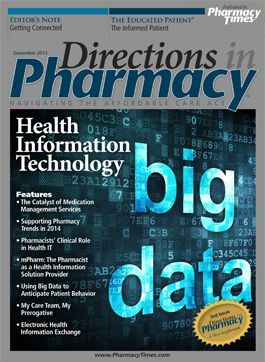Publication
Article
Pharmacy Practice in Focus: Oncology
Health Information Technology: Supporting Pharmacy Trends in 2014
Four major trends will dominate the health information technology landscape during the coming year.



Four major trends will dominate the health information technology landscape during the coming year.
The sages tell us that change is one of life’s constants. And change—particularly constant change—will be seen in all health care sectors in 2014, including pharmacy.
The health information technology (HIT) infrastructure investments that once appeared to be a cost of doing business are catapulting pharmacists and pharmacies into the center of some of 2014’s biggest trends. In short, HIT will create value and help transform pharmacy as it enables the transformation of America’s health care system.
This can be seen in 4 trends for 2014, some of which are well known and others that are under the radar. They are: 1) leveraging HIT for medication therapy management (MTM); 2) supporting an expanded role for pharmacy in care delivery; 3) creating, transforming, and analyzing large data sets, or “Big Data;” and 4) addressing issues related to the rise of specialty medications.
Leveraging Health IT for Medication Therapy Management
One of the biggest trends in health care is the rise of value-based payment models such as accountable care organizations (ACOs). As HIT, exchange capabilities, and care models mature, pharmacists will have access to more data. This will enable them to provide more advanced patient care services, such MTM, and really start to drive value.
As established earlier, beginning with Medicare Part D mandates, ACOs already view MTM—the more complex of which is performed by pharmacists—as essential to care delivery and to meet ACO quality and cost targets. Pharmacists in ACO arrangements are likely to leverage HIT to prevent hospital readmissions through such MTM-related activities as accounting for all of a patient’s medications for direct use, documenting the intended medical purpose for each medication, and determining the objective and patient experience goal for the use of each medication.
As 2014 progresses, it is likely that community pharmacy will also become more active in this space, which has traditionally been reserved for managed care pharmacy. For example, Walgreens announced in January 2013 that it would be leading ACOs in New Jersey and Pennsylvania.
As advanced MTM becomes more widely conducted by pharmacists, the MTM activities and interventions will require information obtained through the health information exchange (HIE). HIE will also provide the means to communicate the pharmacy interventions to other providers. For example, community pharmacists with HIE access could also provide MTM. They could even participate in ACO-like arrangements where they are also incented to improve population management and care quality. Instead of simply checking a box indicating that MTM was performed, they could contract to be measured and incented based on cost and quality metrics achieved across certain patient panels (diabetes, high cholesterol, hypertension, etc).
Supporting an Expanded Role for Pharmacists in Patient Care
Another trend in 2014 is the continued expansion of pharmacy’s role beyond just filling prescriptions. While most health care programs focus on the relationship between the physician and the patient, pharmacists are becoming increasingly relevant to the equation. In fact, pharmacies are providing a growing range of clinical services, including immunizations, some blood tests, specialty drugs, health evaluations, and other so-called “cognitive services.”
The role of HIT is crucial to such activities, as illustrated by its use in immunizations. Pharmacists now are administering a wide range of government-recommended immunizations and vaccines for adolescents, adults, and seniors. Many are then using the HIT infrastructure to deliver immunization data to state, territory, or regional immunization registries. The result is an easier and more efficient way to fulfill state and federal registry reporting requirements. This also can create a more coordinated way to document patient care, which is vital for reimbursement and quality reporting.
Pharmacists also are taking a more expanded and active role as key members of the patient care team in ACOs—and their efforts are facilitated by HIT. As a clinical expert working as part of an interdisciplinary team, for example, the pharmacist can use HIT to help with medication reconciliation and optimizing management of medications on a bedside care team. The result is measurable value. Expanded pharmacist involvement has paid off for the Geisinger Health System, for example. Inclusion of pharmacists on care teams in this integrated delivery system has resulted in fewer strokes, amputations, emergency department visits, and other hospitalizations, not to mention better performance on additional measures that matter to patients.1
In addition to working on collaborative teams, pharmacists, facilitated by HIT, will be essential to ACOs in meeting quality and cost targets through medication reconciliation and other value-driven activities. Connecting pharmacists through HIEs to other members of the care team enhances the quality of the ACO’s care management processes.
Making Use of “Big Data”
Health care is awash in all kinds of data. It comes from the clinical side through electronic health records (EHRs) and registries. It comes from such administrative sources as claims. There soon will be data on costs, use, and outcomes from a variety of new sources, such as the Internet, mobile health, social media, and patients themselves. The question is how to capture and convert these clinical and administrative data into actionable information and create value. The answer is Big Data—or, more precisely, the analytics that can be done by using Big Data.
The idea behind Big Data is to leverage HIT to extract the data, capture such data from disparate streams, and merge them into large sets that can be exchanged electronically through the nation’s HIT infrastructure. They then can be analyzed with increasingly sophisticated analytical tools. The result is actionable information, the scope and breadth of which has not been seen before and whose enormous potential is beginning to become unlocked. According to a recent McKinsey analysis, if the nation’s health care system were to use these big data sets creatively and effectively, the sector could create more than $300 billion annually in value.2 That is why Walgreens recently announced an initiative to collect data from its various lines of business, including home health. Analysis of these data is expected to create financial and administrative savings and enhance the customer experience.
In general, pharmacy is uniquely poised to leverage data and make a real and immediate impact in terms of patient safety, improved outcomes, and lower cost. For example, Big Data can create value by improving medication adherence—a growing problem that is a frequent cause of preventable hospitalizations and patient illness, costing the US health care system an estimated $300 billion annually.3 A prescription-focused research project conducted by CVS Caremark and Brigham and Women’s Hospital shows how Big Data can be used to predict long-term patient medication adherence behaviors using group-based trajectory modeling.4
By analyzing prescription claims data over a 15-month period, the researchers categorized patients into 6 distinct groups from “nearly always adherent” (23.4%) to “virtually no renewals” after their initial fill (23.4%). The study demonstrated that patients with the best adherence fit a certain demographic profile: on average older, a Medicare Part D beneficiary with a higher income, a high school graduate, and several other characteristics. The patients with virtually no renewals were generally younger, male, and less likely to have an initial prescription that provided them with more than a 30-day supply of medication. Rather than yielding only a big picture view, this analysis provided an actionable as well as a concise and specific list of those patients who would benefit from intervention by a care team to ensure adherence.
Data analytics can be used in the fight against fraud and abuse, which is another way it can create value, according to the McKinsey analysis. An example is its use in curbing the growing epidemic of controlled substance abuse and deadly consequences. The Centers for Disease Control and Prevention reports that Schedule II controlled substances have the highest potential for abuse of any prescription drugs legally available in the United States. With this in mind, CVS Caremark took a Big Data approach to the problem and recently evaluated data on Schedule II prescriptions filled at affiliated pharmacies.5 The analysis identified providers with extreme patterns of prescribing opioids, who were then contacted. CVS ultimately suspended controlled substance dispensing for those who could not justify their prescribing habits.
Addressing Issues with Specialty Medications
The use of specialty medications will continue to rise in 2014 and beyond—especially for the growing number of patients who are chronically ill with such complex diseases as cancer, multiple sclerosis, and rheumatoid arthritis. However, specialty drugs are expensive and often complicated to prescribe and dispense.
Increased spending and utilization are major reasons why stakeholders are looking for ways to help contain specialty medication costs. Growth in spending on specialty drugs is far outpacing spending on traditional drugs, and many new drugs are in the pipeline. In fact, recent studies project that by 2015 specialty drug spending is expected to jump by 67% and nearly half of all prescription drug sales will be for specialty medications by 2016.6
HIT will be helping to address those costs through a new standard for electronic prior authorizations (ePA). Use of this standard in the e-prescribing process will create value for pharmacies by facilitating the prior authorization (PAs) that are needed for most specialty medications. The current paper-phone-fax—based prior authorization processes are major pain points for prescribers and pharmacists as well as root causes of the expensive and extensive overhead associated with specialty pharmacy.
Electronic prior authorization was recently developed and made available by the National Council for Prescription Drug Programs. The new standard essentially is a framework incorporated into the SCRIPT standard, which allows the provider to electronically request a PA question set from the payer, electronically return the answers, and receive a response (potentially in near real time). Questions may be customized, depending on the patient and the medication involved; clinical attachments, such as subsets of the medical record, also are supported.
Electronic prior authorization at the point of prescribing will create value for pharmacies by eliminating many PAs from their work queues, which will allow pharmacists to focus on patients and revenue-generating activities. In addition, ePA will help PAs get approved much more quickly, thus helping to improve sales and reduce abandoned prescriptions. ePrescribing also can assist with risk evaluation mitigation strategies, which also are needed for many specialty medications.
Conclusion
It is clear that the role of the pharmacist and the pharmacy is rapidly evolving. HIT is both enabling and supporting these transformational changes as we move into 2014 and beyond.
The use of HIT will create value for new care delivery models that rely on increased pharmacist involvement for patient care—and this will clearly cut costs and improve outcomes.
Jeff Hull, BSPharm, RPh, is a graduate of The Ohio State University, and is currently pursuing a master’s degree in health informatics at the University of Findlay in Ohio. In addition to being a consultant with Point-of-Care Partners, which specializes in e-prescribing, he also works as an independent community pharmacist. He has worked in chain drug store and mail order pharmacy settings and has 15 years of experience in project and change management.
Anthony J. (Tony) Schueth, MS, is founder, chief executive officer, and managing partner of Point-of-Care Partners. A 23-year health care veteran, Mr. Schueth has spent the last 18 years working to provide decision support, communication, and other tools to the point-of-care. He is considered to be an expert in health information technology (HIT) and health information exchange (HIE), in general, and is one of the nation’s foremost experts in e-prescribing. He has a master of science in integrated marketing communications from the Medill School of Journalism at Northwestern University in Evanston, Illinois, and a bachelor of arts in journalism from Butler University in Indianapolis, Indiana.William Hein is a Denver-based senior consultant and the payer/provider/accountable care organization executive lead for Point-of-Care Partners. He has played key roles in the development of several health care companies including Mirixa Corporation, AdvancePCS, and Integrated Medical Systems, and is a provider and payer focused health information exchange pioneer. Bill received a bachelor of science in engineering with distinction at the University of Arizona, where he also pursued postgraduate studies in business while building his first company.
References
- Porter M, Lee T. The strategy that will fix healthcare. Harvard Business Rev. 2013;91(10):50-70.
- Manyika J, Chui M, Brown B, et al. Big data: the next frontier for innovation, competition, and productivity. www.mckinsey.com/insights/business_technology/big_data_the_next_frontier_for_innovation. Published May 2011.
- Braithwaite S, Shirkorshidian I, Jones K, Johnsrud M. The role of medication adherence in the US healthcare System. Washington, DC: Avalere Health; June 2013. www.avalerehealth.net/research/docs/20130612_NACDS_Medication_Adherence.pdf.
- CVS Caremark. CVS Caremark Medication Adherence Report Identifies Significant Opportunities for Health Care Cost-Savings Across All 50 U.S. States. http://info.cvscaremark.com/newsroom/press-releases/cvs-caremark-medication-adherence-report-identifies-significant.
- Betses M, Brennan T. Abusive prescribing of controlled substances—a pharmacy view. N Eng J Med. 2013;369:989-991.
- Stettin G. Specialty drug spending to jump 67% by 2015. Prescription Drug Trends. May 21, 2013. http://lab.express-scripts.com/prescription-drug-trends/specialty-drug-spending-to-jump-67-by-2015.







